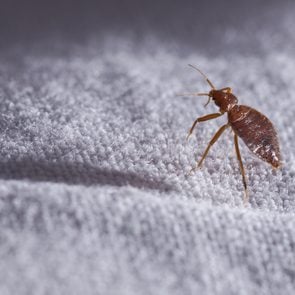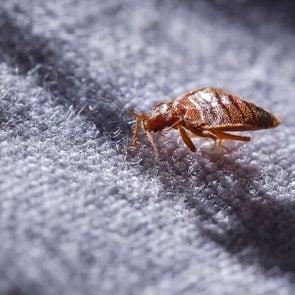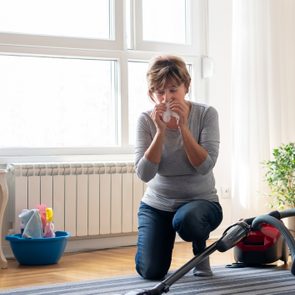Dust Mite Bites vs. Bed Bugs: What’s the Difference?
Updated: Mar. 30, 2022
Dust mites vs. bed bugs is like comparing the lesser of two evils. Here's what to know about their similarities, differences, and how to prevent each.
Battle of the bugs
Nobody wants uninvited guests in their bed, but a couple of types of critters think our warm mattresses come with a neon “occupancy available” sign. Two that love our beds and bedding are dust mites and bed bugs.
But how can you tell which set up camp, and what can you do about it?
It starts with brushing up on your entomology (the study of insects), says Zachary DeVries, an assistant professor of entomology at the University of Kentucky in Lexington.
We dive into everything you need to know about dust mites and bed bugs, according to the experts. Read on for how to tell what’s in your bed and how to prevent each.
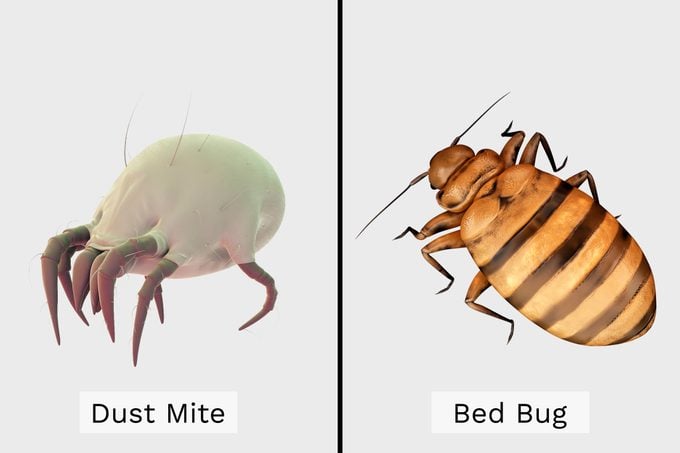
How to tell if it’s dust mites or bed bugs
Dust mites aren’t bugs per se, he explains. They are actually members of the arachnid family and have eight legs, just like spiders, chiggers, and ticks. They are teeny-tiny and are only seen with a microscope.
On the other hand, you don’t need a microscope to see a bed bug if you know where to look. They have six legs and are roughly the size of an apple seed. If the bed bug has recently feasted, it has a reddish-brown color from your blood.
Bed bugs may leave other clues, too. These include a sweet, musty odor, which bed bugs use to communicate with one another, specks of blood, or its outer shell (exoskeleton).
Other signs that you’ve got bed bugs include tiny, dark specks (bed bug feces) or eggs in cracks and crevices of your bed, according to the American Academy of Dermatology.
Neither bed bugs nor dust mites can fly. They tend to hang out in the same places as you do such as your bed and couch.
“House dust mites live where dust accumulates, and bed bugs are found where people are found,” DeVries says.
Another distinction: Dust mites don’t bite. Instead, they feed on your dead skin cell flakes that you shed in abundance every day. (The average adult sheds up to 1.5 grams of skin a day, which can feed 1 million dust mites.)
They are fairly ubiquitous, too. As many as four out of five homes in the US have detectable levels of dust mite allergen in at least one bed, according to the American Lung Association.
“Bed bugs will bite us because they need our blood to survive,” DeVries says. “They are known as ectoparasites because they don’t get inside of our bodies.”
Dust mites vs. bed bugs: how long they live
A dust mite’s life cycle comprises five stages: egg, larva, protonymph, tritonymph, and adult. The transition to adult mite takes one month under optimal conditions. Adult dust mites can live up to two months, and the females can lay anywhere from 50 to 100 eggs.
Bed bugs also have five developmental life stages. They need to shed their exoskeleton to grow larger, and this requires taking a blood meal. It can take about 37 days for a bed bug egg to become an adult, and adult bed bugs can live for up to one year provided they are well fed, according to entomologists at Virginia Tech.
Exactly how many eggs a female bed bug lays depends on how often she eats. The more she eats, the longer she lives, and the more eggs that she can lay.
Bed bugs tend to strike at night, and meal lasts about 4 to 12 minutes, per the Environmental Protection Agency (EPA). They dine and ditch, too, returning to their hiding place as soon as they are full.
Some good news? Neither bed bugs nor dust mites transmit diseases, DeVries says.
The symptoms of bed bugs vs. dust mites
Dust mites only cause symptoms, including sneezing, sniffling, runny eyes, and coughing, if you are allergic to them. Unfortunately, 20 million Americans are allergic to dust mites, according to the Asthma and Allergy Foundation of America.
Here’s what happens: You inhale microscopic fecal matter and dead body parts of dust mites, and your body’s immune system goes on the attack and produces antibodies against the mites, starting the process that causes sniffling, sneezing, itchy eyes, and other allergy symptoms.
Bed bugs don’t cause allergies, but you can develop an allergic reaction to a bed bug bite. This may result in severe itching, blisters, or hives around the bite or bites, DeVries says. (Here’s how to tell the difference between bed bug bites vs fleabites.)
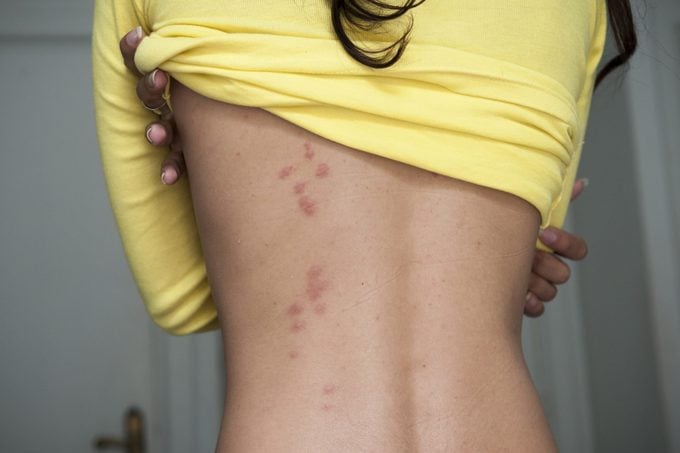
Bed bug bite identification and treatment
Is it a bed bug bite? The only way to know for sure is to find the culprit.
“Bed bug bites are not always linear,” DeVries says. “They can be spread out haphazardly.”
You may see clusters of red bites or welts that appear on areas of skin exposed during sleep, such as your face, arms, and trunk. (Here’s how to spot the difference between a chigger bite and a bed bug bite.)
You can treat most bed bug bites at home by washing the area with soap and water, and applying an anti-itch cream to soothe the itch, according to the American Academy of Dermatology.
The bites usually heal within a week or two. If you see signs of an infection such as pus or an allergic reaction such as hives, see your doctor as you may need more aggressive treatments.
Keep these other home remedies for bed bugs in mind, too.
Dust mite allergy diagnosis and treatment
If you think you may be allergic to dust mites, see an allergist for further testing. Skin prick and/or blood testing can help determine what is causing your symptoms. Your doctor will also ask you about your symptoms and when they are most likely to occur for a fuller picture of what is going on.
Dust mite allergy treatments are allergy shots or immunotherapy, says Russell Leftwich, MD, an allergist in Nashville, Tennessee, and an American Academy of Allergy, Asthma & Immunology spokesperson.
These shots gradually introduce dust mite allergens to your immune system in the hopes that the next time it encounters such allergens, it won’t launch an attack.
Other treatments focus on symptom relief. If you’re stuffed up, a nasal spray or oral antihistamine can help, while eye drops may soothe irritated eyes, Dr. Leftwich says.
Dust mites vs. bed bugs: prevention
It’s almost impossible to get rid of dust mites entirely, but there are lots of things you can do to reduce your exposure to these critters around your home.
For starters, consider mattress and pillow coverings that keep dust mites out. Bonus: these can also help keep bed bugs away, DeVries says.
“They keep dust mites out and can make it harder for bed bugs to grab onto your mattress,” he says.
Finely woven fabrics may keep dust mites out, according to a 2018 study in The Journal of Allergy and Clinical Immunology.
(Here’s how to get rid of dust mites.)
Vacuuming with a high-efficiency particulate air (HEPA) filter also helps get dust mites out of carpets. If you are not using a HEPA filter, your vacuum could release dust mites back into the air around you. These are the best HEPA filter vacuums if you have allergies.
A portable HEPA filter that you can take from room to room can also help clear the air of dust mites, pollen, and other potential allergens. (Do you need a HEPA filter? Find out here.)
Make sure to wipe down all surfaces so your environment is as dust-free as possible, DeVries says.
Lower the humidity around your home to below 50 percent as dust mites need humidity to survive, DeVries says. They don’t drink water, so they need to absorb it from the environment. They also need temperatures of 68 to 77 degrees Fahrenheit (20 to 25 degrees Celsius) to thrive, he says.
Eliminate clutter, says Neeta Ogden, MD, an allergist and immunologist in Edison, New Jersey, and an American College of Allergy, Asthma, and Immunology (ACAAI) spokesperson. Replace drapes with blinds and wall-to-wall carpet with washable area rugs, or with hardwood floors, she says.
Getting rid of bed bugs is a little trickier, DeVries says. There is no need to use ƒpesticides or insecticides to get rid of dust mites, but you may need these bigger guns for bed bugs.
Many chemicals can deal with a bed bug infestation such as pyrethrin, pyrethroids, and insect growth regulators. They all work differently, and sometimes more than one class is needed, according to the EPA.
You may need to call in the pros for this type of clean-up, DeVries says.
Heat treatments are another option for getting rid of bed bugs. “These will heat your house up to 120-130 degrees and cook bed bugs,” he says. These can treat large or small areas.
Another way to kill bed bugs and dust mites is to put the infested item into the dryer on a high-heat setting, he says. “If you want to wash it you can, but it’s the high heat that will destroy these pests.” Extreme cold works too. If you can’t put it in a dryer, place it in the freezer for two days in a zip lock bag, he suggests.
Knowing the difference between bed bugs and dust mites is the first step toward getting these unwanted visitors out of your bedding and home.




















